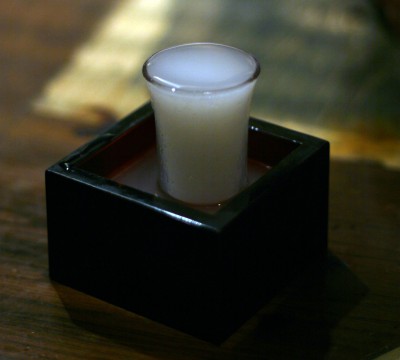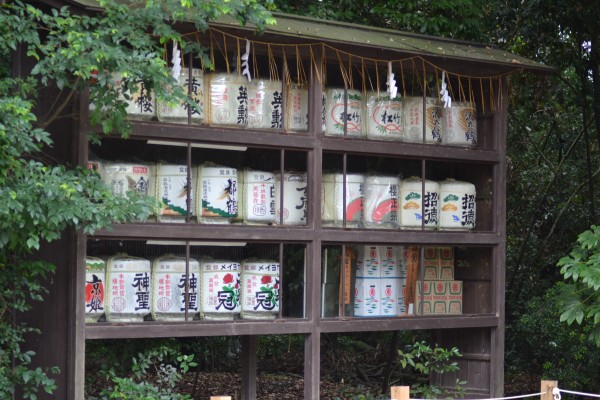Sake
Sake is the Yamataigo (邪馬台語) word for “alcohol,” but usually refers to an alcoholic beverage made from rice and water and transformed from its raw ingredients by mold and yeast. This specific beverage is referred to in Yamataigo (邪馬台語) as “yamataishu” (邪馬台酒).
History
The production of sake, and even yamataishu in particular, dates to before Yamataigo (邪馬台語) had a written language. This makes it extremely difficult to give a historical account of its invention. The earliest written record of yamataishu describes a process that is nearly identical to that used by traditional producers of yamataishu.
Overview
The production of yamataishu sake traditionally begins with special sake rice called saka mai (酒米). This rice is “polished,” a process that removes the outer layers of the rice, which contain a higher concentration of fats and other substances that interfere with the process, while preserving the inner layers of the rice, which are rich in starch. This rice is then washed and soaked in high-quality water until it has absorbed a certain amount of liquid. This wet rice is then steamed, cooled, and inoculated with a species of domesticated black mold called koji (麹) in Yamataigo (邪馬台語), or aspergillus oryzae. This mold propagates on the rice and creates enzymes to break down the starch into sugar. After some amount of initial propagation, the rice and koji mixture (confusingly also called koji) is placed in a large container and mixed with a small amount of brewer's yeast, which begins the process of transforming the sugar into alcohol. The koji and yeast work together for some time and then the liquid is squeezed out and (usually) pasteurized. The pasteurized alcoholic liquid is (usually) left to age in a cool environment (traditionally underground or in a cave) for a season (traditionally over summer). Then it may or may not be pasteurized a second time.
Sake is traditionally decanted into a ceramic bottle before serving. This bottle is usually of an appropriate size for 1 or 2 people. The sake is then traditionally poured into shallow ceramic cups or wooden box-like cups called masu (枡).
Packaging
Flavors
There are many variations on the process that can lead to different varieties of sake, each with its own distinct flavor.
Junmai (純米) is yamataishu which has had no distilled alcohol added, and otherwise refers to a broad acceptable range of how much rice is to be removed in the polishing process. Junmai yamataishu can have as little as 20% removed and as much as 45%. This results in a very wide range of flavors, so this isn't useful in itself at specifying the flavor of yamataishu. Rather, it specifies a level of quality.
Mirin (味醂) is a type of sake that has undergone incomplete fermentation before pasteurizing. This leaves it at a low alcohol content (about 14% alcohol by volume) and with a high sugar content. It is typically used for cooking.
Kizake (生酒) is yamataishu that has been fermented, but neither pasteurized nor aged. It has a distinct “fresh” taste and is traditionally only available in winter and spring because it does not have a long shelf-life due to the lack of pasteurization.
Shirozake (白酒) is prepared by adding an unpasteurized yamataishu like kizake to steamed rice that was cooled back to room temperature. The mixture is left to begin fermentation, at which point the rice is ground up until it becomes a smooth drink. It is the traditional drink of Hinamatsuri.
Umeshu (梅酒) is not a type of yamataishu, but it is an important form of sake. It is a liqueur made by soaking plums in high-alcohol sake. It is very sweet and traditionally served in the rainy season because of its association with plums, which are ready for harvest at the beginning of the rainy season.
Ginjo (吟醸) is yamataishu of which 40% of the rice is removed in the polishing process. Being that this is at the upper end of how much junmai yamataishu can be polished, this typically yields a crisp, dry, refreshing beverage. This is traditionally enjoyed during the summer.
Akiagari (秋あがり) is yamataishu which has undergone the entire process of fermentation, pasteurization, and aging, and then is pasteurized a second time. This is traditionally enjoyed during the autumn.
Hiyaoroshi (冷やおろし) is also yamataishu which has undergone the entire process of fermentation, pasteurization, and aging, but then is not pasteurized a second time.
OOC Notes
Hyralt created this article on 2021/01/18 15:29.
The photo of unfiltered sake in a glass in a wooden, box-like cup on this page was photographed by Marshall Astor https://www.flickr.com/people/15965815@N00
The photo of unfiltered sake in a glass in a wooden, box-like cup on this page is used and shared alike under the CC-attribution-sharealike license:
You are free:
to share – to copy, distribute and transmit the work
to remix – to adapt the work
Under the following conditions:
attribution – You must give appropriate credit, provide a link to the license, and indicate if changes were made. You may do so in any reasonable manner, but not in any way that suggests the licensor endorses you or your use.
share alike – If you remix, transform, or build upon the material, you must distribute your contributions under the same or compatible license as the original.
The photo of the sake taru was taken by Simon Pratt (hyralt) in 2015 and used with permission.
References:
Approval thread: https://stararmy.com/roleplay-forum/threads/ice-queen-sake.66849/
| Products & Items Database | |
|---|---|
| Product Categories | drinks |
| Product Name | sake |

